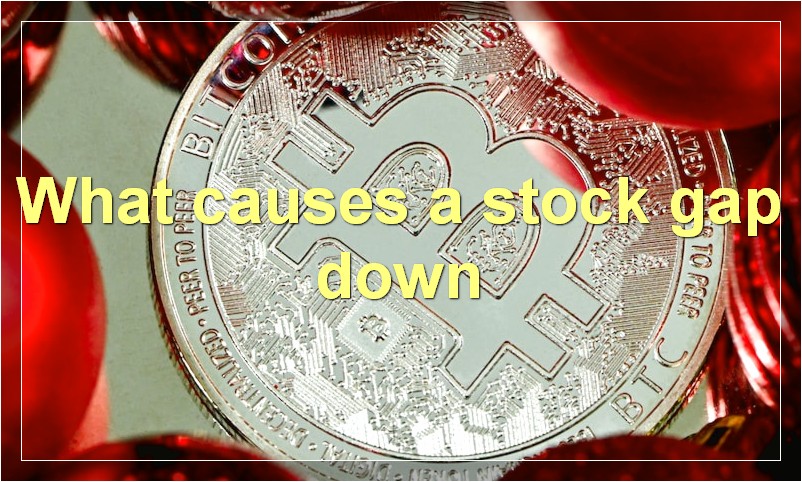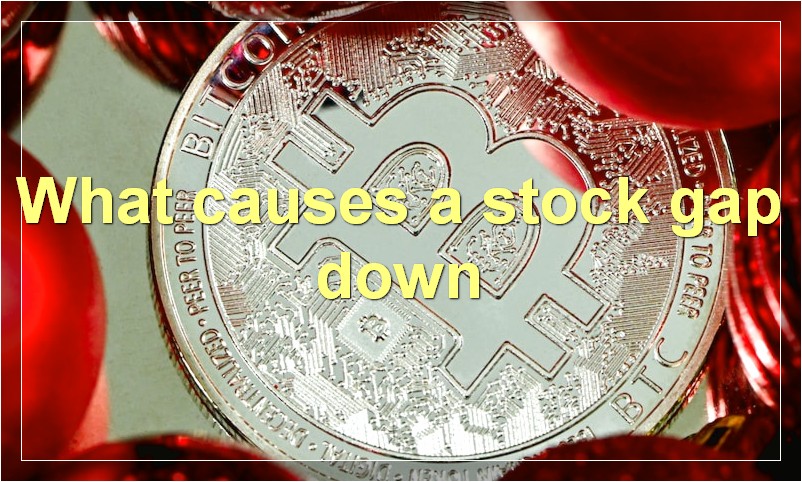The stock market is unpredictable. One day it’s up, and the next day it’s down. So, how do you trade a stock gap down?
What is a stock gap down
When a company’s stock price suddenly drops, it’s called a “gap down.” This usually happens when there’s some sort of bad news about the company, like an earnings miss or a disappointing guidance. The stock price may gap down below the previous day’s low, or it may gap down below the day’s open. Either way, it’s a sign that investors are quickly losing confidence in the company.
Gap downs can be especially painful for investors who are caught off guard. If you’re holding the stock, you may see your investment lose a lot of value in a matter of minutes. And if you’re thinking about buying the stock, you may have to wait for the price to stabilize before getting your chance.
Of course, not all gap downs are created equal. Some may be due to temporary factors that eventually go away. Others may signal the beginning of a long-term decline. As an investor, it’s important to do your research and try to understand why the stock is gapping down before making any decisions.
What causes a stock gap down

When a company reports earnings that miss analyst expectations, the stock often gaps down the next day. This is because investors were expecting better results, and they sell the stock in disappointment.
There are a few other reasons why a stock might gap down as well. If a company issues a profit warning, for example, investors will likely sell the stock in anticipation of lower earnings. And if a major competitor announces strong results, that can also lead to a gap down for the affected company.
Whatever the reason, a gap down can be a sign that investor sentiment has turned negative on a stock. And it’s often an early warning sign that more trouble may be ahead.
How do you trade a stock gap down
When a stock gaps down, it means that the price of the stock has dropped sharply in between trading periods. This usually happens when there is some sort of news that has come out about the company that is negative. For example, if a company announces that its earnings are going to be lower than expected, the stock might gap down.
If you want to trade a stock gap down, you need to be quick. As soon as the market opens, you need to place your order. The reason for this is that stocks often bounce back quickly after a gap down. So, if you can get in at the right time, you might be able to make a quick profit.
However, you also need to be careful. If the news that caused the gap down is bad enough, the stock might continue to drop. So, you need to make sure that you have a stop loss in place just in case.
What is the difference between a stock gap up and a stock gap down
When a stock gaps up, it means the price of the stock rose overnight or during the current trading day. This usually happens when there is some good news about the company, such as an earnings surprise.
When a stock gaps down, it means the price of the stock fell overnight or during the current trading day. This usually happens when there is some bad news about the company, such as an earnings miss.
How do you identify a stock gap down
When a stock gap down, it means that the stock has opened lower than it closed the previous day. This usually happens when there is bad news about the company, such as poor earnings results.
What are the consequences of a stock gap down

When a stock gaps down, it means the price of the stock fell sharply in between trading sessions. This usually happens when there is some sort of news that investors believe is negative for the company. The consequences of a stock gap down can be serious for investors.
If you own the stock that gaps down, you may see a sudden drop in the value of your investment. This can be concerning, especially if you were counting on the stock to provide you with income or capital gains. If the gap down is severe, it could even trigger a margin call from your broker.
If you don’t own the stock but are watching it closely, a gap down can signal that it’s time to sell. After all, if the news is bad enough to cause such a sharp drop in price, it’s likely that more bad news is on the way. Investors who are quick to sell when a stock gaps down can avoid further losses.
Of course, not all stock gaps down are created equal. Sometimes, a company will release bad news but the stock price doesn’t reflect the true extent of the damage. In these cases, patient investors can actually use a gap down as an opportunity to buy shares at a discount.
No matter what your strategy is, it’s important to pay attention to stocks that gap down. These sudden movements can have serious consequences for your portfolio.
Is a stock gap down always bad news
When it comes to stocks, there is no definite answer as to whether a gap down is always bad news. It depends on various factors, such as the company’s financial stability, the market conditions, and investor sentiment.
Generally speaking, a stock gap down may indicate that the market is bearish on the stock. However, this is not always the case. For example, if a company announces poor earnings results, then the stock may gap down in reaction to this news. However, if the company has strong fundamentals and is still growing, then the gap down may be seen as a buying opportunity by some investors.
In the end, it really depends on the individual situation. There is no clear-cut answer as to whether a stock gap down is always bad news.
How can you take advantage of a stock gap down
If you’re quick on your feet, stock gaps can present opportunities to buy low and sell high. But what is a stock gap, and how can you take advantage of one?
A stock gap is simply a difference between the price at which a stock opens and the price at which it closed the previous day. This can be caused by a number of things, such as news announcements or changes in the overall market.
If you think a stockgap is going to occur, you can place a buy order just below the opening price. Then, if the stock does gap down, you’ll be filled at a lower price than everyone else. Of course, you need to be careful that the stock doesn’t continue to fall after you’re filled, or you could end up with a loss.
Alternatively, you could wait for the stock to gap down and then place a limit buy order at the bottom of the gap. This way, you know you won’t pay more than necessary for the stock.
Of course, there’s no guarantee that a stock will gap down just because you think it might. So it’s important to do your homework and only try this strategy with stocks that you’re confident will gap down.
What are some strategies for trading a stock gap down
There are a few different ways to trade a stock gap down. One way is to wait for the stock to start to rebound off the lows and then enter a long position. Another way is to enter a short position when the stock starts to fall and then cover when it hits support.
If you are looking to trade a stock gap down, it is important to have a plan and know what your strategy is before entering the trade.
Are there any stocks that commonly experience a gap down
There are a few stocks that commonly experience a gap down, typically due to bad news coming out about the company. This can be a sign that the stock is not doing well and is not a good investment.

